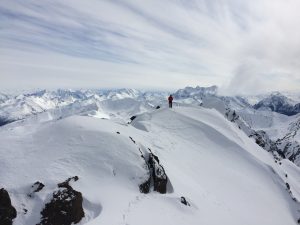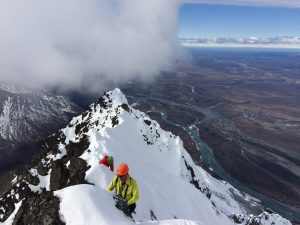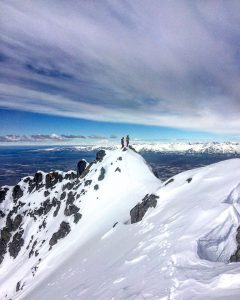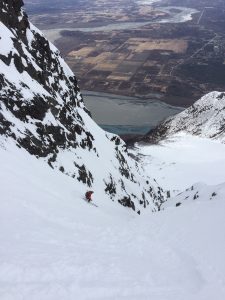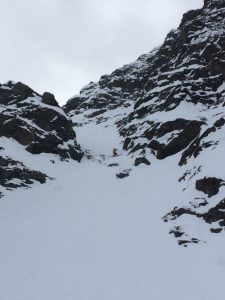Skiing is dangerous, and backcountry skiing is even more dangerous. Extreme steep skiing involving alpine climbing involves consequences that include serious injury and death. Objective hazards (e.g. avalanche danger and rock fall) may be present, and the consequences of a fall or other subjective (e.g. decision-making) mistakes could be fatal. You are responsible for your own safety. The decision to pursue an objective like what’s discussed below cannot be taken lightly; it takes years of gaining knowledge and experience to pull it off.
Pioneer is an iconic Western Chugach peak; it’s the mountain featured on the AK driver’s license. It’s north face (pictured on the DL) is a classic spring alpine climb, and a prize ski descent. Not to say it hasn’t been skied on a below average snow year before, but all reports are only of it being skied on big years…when the entirety of its 6300′ north face can be booted up without crampons let alone technical gear like mixed climbing pro, ice tools, rope, ski crampons, etc. While skiers tend to limit their fathoming of this line to above average snow years when the technical equipment is not required, the technical approach is the standard fare of alpine climbers that enjoy the ascent annually each spring.
I’ve wanted the line for years and waiting for that above average year, that seems ever more fleeting due to climate change and a sea level snowpack seeming more and more like a thing of the past, became too ephemeral for my temperament. As I’ve become more entranced by climbing in recent years, and remain ever entranced by steep skiing, it was time to put the two together. After all, Alaskan ski culture is late coming around to a purer form of steep skiing and ski mountaineering: a form that doesn’t involve high carbon emissions and deep pockets; the form of the Randoist. This form is found flourishing in places like Jackson, Salt Lake City, and many areas of Europe.
So it began on April 7, 2016 that Sam, Russ, and I headed to the OG Highway for our shot at de-mystifying the North Face of Pioneer (colloquially known as “The Driver’s License” to bro-brahs).
On an average to below average year, with little to no low elevation snowpack, expect to:
- Walk on dry ground and scree for ~.25 mile and 500′
- Walk on chunky, icy avalanche debris (perhaps mixed with scree in areas) for another ~.25 mile and 500-1000′
- Climb a short pitch of thin and hard to protect WI2-3 for the direct route, or head to a gully climber’s right for a steep, somewhat schwacky ascent line that had a fixed rope spring 2016
- Boot another 500-1000′ of steep, icy snow in either of the lower ascent gullies
- Skin or boot another 1500′-2500′ feet of variable, moderately steep snow (ski crampons recommended for skinning in this section)
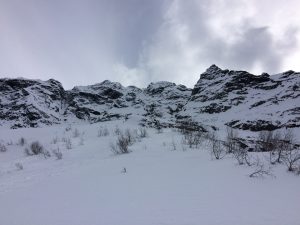
- Deal with ~500′ of more exposed terrain requiring a pitch of hard to protect ~M4 or ~WI3 climbing for the direct route, or a long steep traverse climber’s right up a thin snow chute then hard left along an exposed snow ramp above cliffs
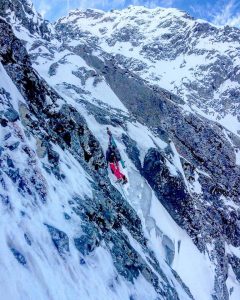
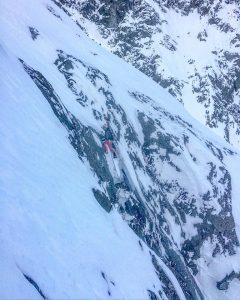
- Boot or skin another ~500′ of moderately steep snow (softer and more sheltered in this area)
- Boot a final 1000-1500′ of steep snow (softer and sheltered) to the summit ridge
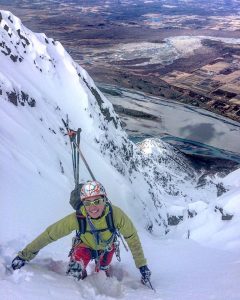
For the descent:
- Follow your tracks down for ~2000′ to above the most exposed terrain of the route (where you either did the direct M4-WI3 pitch or the exposed traverse).
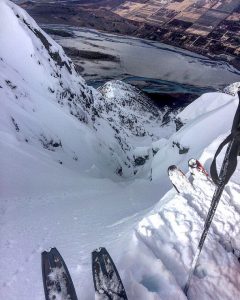
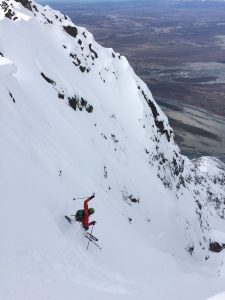
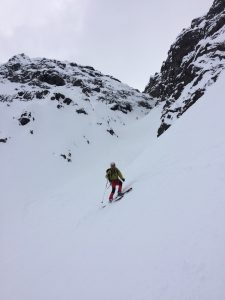
- Traverse skier’s left of your ascent route (if you went direct through the ice or mixed terrain) through exposure and look for a chute that connects the upper and lower snowfields (the chute is skinny with thin snow through the choke, likely requiring a bit of “dry-skiing” on below average snow years).
- Descend the lower gully on skis or snowboard as far as possible, minding the encroaching vegetation and exposure below. If you climbed the direct gully with the lower ice pitch, descend the next gully skier’s left to avoid a rappel.
- Boot down the gully (crampons recommended) and descend the steeper part using the fixed line, “veggie belays,” or rappel on your own line if deemed necessary.
- Walk back down the icy avalanche debris.
- Walk back down the scree and dry ground to the road.
Recommended gear:
- Skis: shorter and lighter to allow for more efficient travel and easier technical climbing (e.g. Voile Objective, Black Diamond Helio 88, Dynafit Cho Oyu)
- Bindings: we’re talking about exposed, steep skiing. Ripping and hucking this sort of terrain is borderline suicidal. Tech bindings under 200 grams are more than enough for careful, calculated turns and make the ascent more efficient and enjoyable. Check out the options from Dynafit, Plum, and Kreuzspitze.
- Boots: do you really need more than two buckles? The Dynafit TLT6 has excellent ski-ability and is still a capable boot for this level of climbing even on more technical years. Arc’Teryx has a new boot that seems like it will be a very capable climber, that can also ski. Sportiva, Scarpa, and Fischer have other lightweight options with acceptable ski-ability.
- Skins: a lighter weight mohair mix is where it’s at for this and similar type adventures. I can vouch for Black Diamond and Pomoca.
- Ski crampons: they’re often a must for secure skinning on the regularly hardpacked snow areas of the Western Chugach. I use Dynafit ski crampons because I have Dynafit bindings. B&D ski gear seems to be another quality option.
- Crampons: I’d take lightweight aluminum crampons even if it was a bigger year with little to no ice, and steel crampons on thinner years when more technical climbing is required (e.g. CAMP XLC 390 or XLC Nanotech; Black Diamond Neve, Cyborg, or Snaggletooth). The CAMP crampons fit ski boots great right out of the box. The BD crampons may require a larger toe bail that’s sold separately.
- Ice tools: Black Diamond Cobra or Viper for the more technical years; Black Diamond Venom for less technical years. Something like the Cassin X-Light or Petzl Sum’Tec might be the sufficient ticket for the range of climbing conditions from year to year.
- Rope: I’d recommend being comfortable soloing this sort of terrain before committing to this adventure. That said, I’d still bring a light rope. Since you’d be comfortable soloing, and aren’t going to fall, a dynamic rope in the 7mm range would be an efficient choice. The Beal Gully Unicore is my choice.
- Protection: again, I’d recommend being comfortable soloing WI3 and M4 before committing to this climb and ski. That said, a few shorter ice screws and a handful of pitons would be prudent. My life regularly relies on Black Diamond climbing protection.
- Pack: it’s tricky to find one that works great for this sort of thing; that is, dealing well with both skiing and climbing gear. RandoMan has made some alterations to a Patagonia Ascensionist that may be the best thing I’ve seen. I think the new Cirque pack from Black Diamond is going to be the best thing out there when it’s released Fall 2016.
- Clothing: light and breathable for high output climbing and skiing with lightweight insulating and shell layers. I typically incorporate items from Patagonia, Black Diamond, Outdoor Research, and Mountain Hardwear. They all offer great products.
A great place to explore gear for serious ski-mountaineering is SkiMo Co.
~Mat

